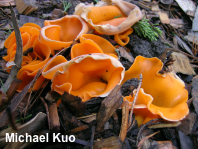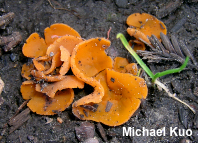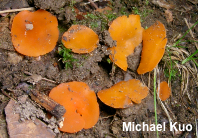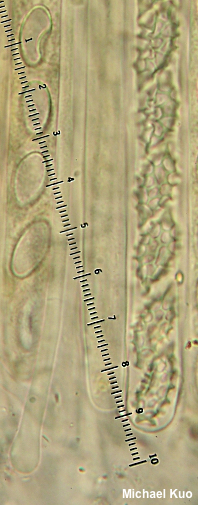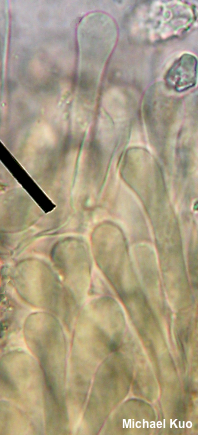| Major Groups > Cup Fungi > Aleuria aurantia |

|
Aleuria aurantia [ Ascomycota > Pezizales > Pyronemataceae > Aleuria . . . ] by Michael Kuo Sometimes called the "orange peel fungus," this attractive and often fairly large cup fungus is bright orange, with a fuzzy whitish underside (at least when young). Aleuria aurantia occasionally develops a slit down one side, reminiscent of species of Otidea (see Otidea onotica for an example), but it does not consistently do so, and it is more brightly colored than most Otidea species. Under the microscope, Aleuria aurantia has spores that become marvelously reticulate and develop long points ("apiculi," in Mycologese) at each end. Sowerbyella rhenana is a similar but smaller species that develops a stem. Aleuria cestrica is also similar but smaller; it is like a miniature version of Aleuria aurantia (its spores even develop reticulation and apiculi, but are much smaller). Orange species of Lachnellula are much smaller, maxing out at a few millimeters, and grow on deadwood. Aleuria wisconsinensis, described by Rehm (1904) from Wisconsin, is a synonym according to Haffner (1993). Description: Ecology: Traditionally labeled as saprobic but possibly mycorrhizal (Hobbie et al. 2001); usually growing in clusters on the ground, often in clayey soil or disturbed ground (roadbanks, trails, and so on); also appearing in urban habitats in landscaping and occasionally on woodchips; summer and fall, or over winter in warm climates; widely distributed in North America; also known from Europe, South America, Asia, and Australasia. The illustrated and described collections are from California and Illinois. Fruiting Body: Cup-shaped, often becoming flattened or irregularly shaped as a result of the clustered growth habit; 1.5–7 cm across; without a stem, but pinched together at the point of attachment. Upper Surface: Bright orange and bald. Undersurface: Usually whitish-fuzzy, at least when young, but often dull orange and more or less bald by maturity. Flesh: Pale yellow to orangish; brittle. Odor: Not distinctive. Chemical Reactions: KOH negative on upper surface. Microscopic Features: Spores 11–16 x 4–8 µm (without ornamentation); ornamentation as a well-developed reticulum 0.5–2 µm high; developing polar apiculi 1–3 µm long; smooth and ellipsoid before maturity; hyaline in KOH; golden in Melzer's. Asci 125–200 x 6–12.5 µm; 8-spored; tips inamyloid. Paraphyses 125–185 x 2.5–5 µm; filiform below clavate to subclavate, straight apices; septate; smooth; with orangish contents in KOH; hyaline to yellowish in Melzer's. Excipular surface elements 40–100 x 9–12 µm; cylindric with rounded or subclavate apices; smooth; yellow in KOH and Melzer's. REFERENCES: (Persoon, 1800) Fuckel, 1870. (Fries, 1822; Seaver, 1928; Smith, Smith & Weber, 1981; Breitenbach & Kränzlin, 1984; Arora, 1986; Phillips, 1991/2005; Lincoff, 1992; Haffner, 1993; Barron, 1999; Hobbie et al., 2001; Roody, 2003; McNeil, 2006; Trudell & Ammirati, 2009; Beug et al., 2014; Kuo & Methven, 2014; Desjardin, Wood & Stevens, 2015; Evenson, 2015; Siegel & Schwarz, 2016; Woehrel & Light, 2016; Baroni, 2016; Læssøe & Petersen, 2019.) Herb. Kuo 01140503, 01110604, 01151106, 10071206. This site contains no information about the edibility or toxicity of mushrooms. |
© MushroomExpert.Com |
|
Cite this page as: Kuo, M. (2020, January). Aleuria aurantia. Retrieved from the MushroomExpert.Com Web site: http://www.mushroomexpert.com/aleuria_aurantia.html. |
